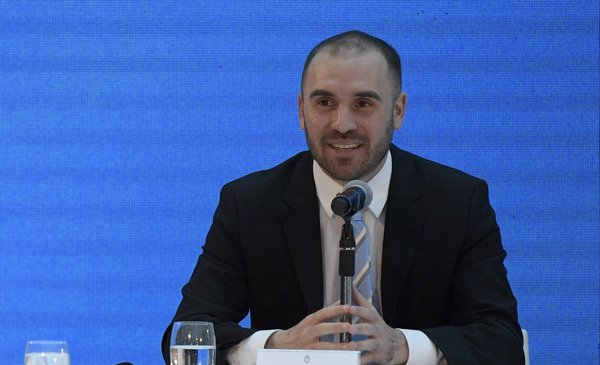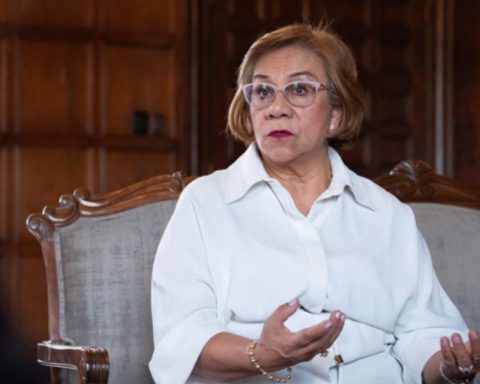The Argentine government sent this Friday to Congress the agreement finally reached with the staff of the International Monetary Fund (IMF)Which will allow reschedule payments to the agency for this year and 2023 and clears the financing scenario for the coming years.
The bill approves the Extended Facilities program for around US$ 45,000 million, what replaces the stand-by agreement of 2018 signed by the management of Mauricio Macri for US$ 57,000 million, of which the country received almost US$44 billion.
The project sent to Congress includes as annexes all the documents that make up the agreement, that is, the Memorandum of Economic and Financial Policies and the Memorandum of Technical Understanding. The chronicler had access to the 137 page project sent to the Chamber of Deputies of the Nation.
ANDREW CABALLERO-REYNOLDS / AFP
IMF President Kristalina Georgieva.
Taking into account that the agreement supposes the refinancing of the debt taken by the previous government, the Ministry of Economy clarified that “we ask the Fund for money to pay the Fund” the maturities of that loan and in this way “improve the profile of net maturities with respect to the unsustainable one that Together for Change left us and that Argentina can continue to grow”.
As the Fund does not accept debt restructuring, progress was made on a new program, whose central axes are as follows:
1) Duration and revisions
It is specified that it will have a duration of 2 and a half years in relation to the commitments assumed. In that period there will also be 10 quarterly reviews, with disbursements in each of them.
The repayment of the same will be between 2026 and 2034, earning 4 and a half years, “without sacrificing money from Argentina to pay debt in these two and a half years.”
2) Maturities and disbursements
The first disbursement from the IMF will be US$9.8 billion ($7 billion in SDR), which will arrive as soon as the bill is approved. It will be key because on March 22 some US$ 2,800 million from the previous program are due and there are not the resources to pay. In addition, this month we must also pay a due date to the Paris Club.
The US$ 9,800 million will serve to strengthen the reserves. The maturity schedule of the 2018 Stand By agreement established maturities of US$19,000 million this year and about US$20,000 in 2023.
3) Adjustment policies and social inclusion
This agreement, according to the government, was reached no adjustment policies and with an increase in real spending in all the years of the program, something unusual in financing programs with the IMF.
There will also be expansion infrastructure, Science and Technology and policies to strengthen social care and transition from social plans to genuine employment.
There will be a focus on fight child poverty and redirect aid to promote inclusion in the labor marketespecially for women and workers with low or insufficient qualifications.
This “allows a passable path for our country with greater predictability, certainty and vision of the future,” the government said.
On the other hand, and as specified by the President Albert Fernandez In his opening speech of the ordinary sessions of Congress, the agreement does not contemplate any pension reform or labor reform.
4) Public works
It is planned to increase investment in infrastructure to more than 2% of GDP in 2022starting from an average of 1% of GDP in 2018-20) and maintain this level throughout the program.
The investment will focus especially on improving the housing and health conditions in the poorest urban areas, and in reinforcing the road, energy, digital and logistics infrastructure of the country. In addition, spending on science and technology will be protected and expanded to promote innovation.
5) Fiscal deficit and debt
A “virtuous reduction of the fiscal deficit” is proposed, which means that it will be accompanied by real growth.
“We have drawn up a multi-year fiscal consolidation strategy, in which a primary deficit of 2.5% of GDP in 2022 has been set as a goal, which will be reduced to 1.9% of GDP in 2023, and to 0.9% in 2024,” said the Ministry of Economy.
After many years, with the agreement, Argentina could move towards a countercyclical fiscal policy. This assumes that if the real revenues of the federal government were higher than programmed, there is a commitment to take advantage of the opportunity to duly reduce the fiscal deficit as appropriate, to ensure that the baseline fiscal target scenario is met, even in the face of an adverse external shock. .
The expansion of the public debt denominated in pesos will be especially sought, as well as the support of the international community (debt taking in dollars), which “will facilitate the total elimination of the monetary financing of the deficit by the end of 2024.”
6) Fees
there will be a a increase in utility rates that users pay, from a reduction in subsidies, especially in energy (electricity and gas).
The sectors with the greatest economic capacity will contribute to a greater extent to the reduction of energy subsidies and the rest will have increases that will be below the rise in wages. It will cover both residential and non-residential users (industries and businesses).
The 10% with the greatest ability to pay will not have more subsidies and will pay the full rate. Those who have a social rate will have a maximum annual increase of 20% and the rest will have average increases of 42% (80% of the salary variation coefficient).
7) Inflation
An understanding was reached that inflation is multi-causal and not just a purely monetary phenomenon as the previous government and the IMF of that time affirmed. Reducing inflation lastingly will require a comprehensive program of economic policies.
To do this, an important pillar will be to have a sustainable fiscal and financing path, which will help reduce budget financing by the Central Bank without delay.
From the government they also assured that “it will be essential to complement this with a prudent and proactive monetary policy to support the demand for assets in pesos.” “Voluntary price and income policies” will also be promoted, in the face of the inertia of inflation and the de-anchoring of expectations from inflationary dynamics.
8) Pricing care and income policies
A voluntary price agreement (Care Prices) is in force with more than 150 participants from the private sector, so that price increases do not exceed 2% per month in 1,300 representative products of the mass consumption basket. Price agreements will be a complement to existing wage agreements to support real wage growth.
9) Devaluation
A sharp jump in the exchange rate is not expected. The objective is to “calibrate” the management of the (official) exchange rate to ensure the medium-term competitiveness of the real effective exchange ratealso encouraging the accumulation of reserves.
To achieve the reserve accumulation goals under the program, “the official exchange rate adjustment rate will maintain the effective real exchange rate in 2022.”
10) Interest rate
It was agreed as an objective to have a structure of positive real interest rates, above inflation, to strengthen the demand for assets in pesos and contribute to exchange and financial stability.
The Chronicler-RIPE

















